At least for birds in flight.
Since the mirrorless Canon R5 was released about two years ago there’s been a lot of hype about it being a “game changer” for bird photographers. I tend to be a skeptic about such claims and I also knew that mirrorless cameras in general are a little freaky in the way they operate. So even though I began looking for a new camera that would suit me at just about the time the R5 came out, I resisted purchasing it (or the somewhat similar R6) for a very long time. The damn thing is expensive (nearly $4K) and I sure didn’t want to spend that much money on a camera that wasn’t a major improvement over my Canon 7D Mark II, or was too quirky for me in the way it operates, or both. But two months ago I was finally seduced so I took the plunge.
Today’s post will not be a comprehensive review of the R5. I’m going to focus on a specific capability that is very important to me – photographing birds in flight and doing it well. I’ll use a single series of photos of a bird in flight that I think offers pretty strong evidence to support the premise that at least some of the hype is actually backed up by performance.
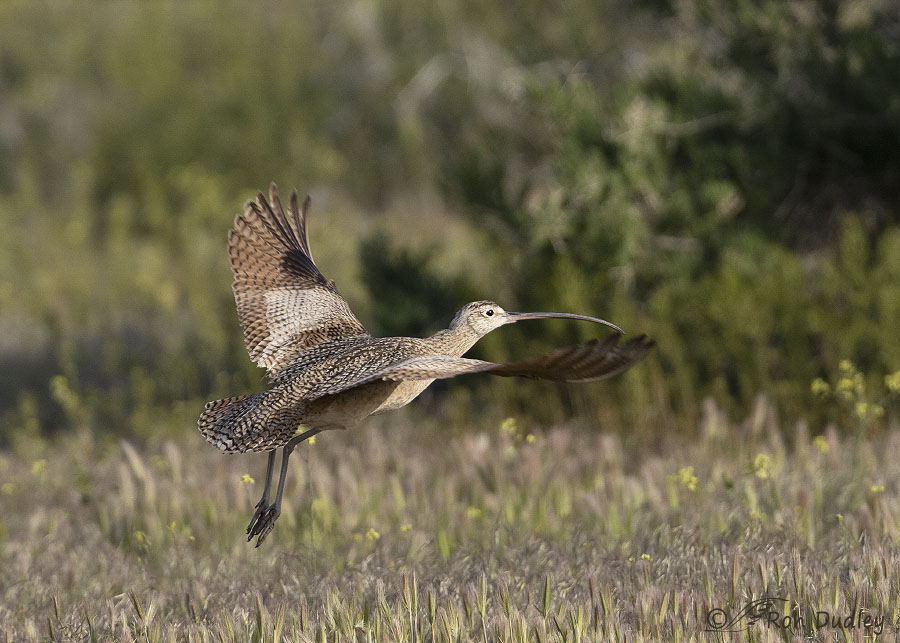
Four days ago on Antelope Island I got this male Long-billed Curlew in my viewfinder just before he took off. He was far away and small in the original frame (this version of the first photo has been cropped significantly – you’re about to see how significantly). I got 12 photos of him in flight, presented below.
- All 12 photos are presented in the order they were taken, without any skips
- All of them are cropped exactly the same amount, a large amount. The original roughly 46 MB images are all cropped to 8 MB – only 17.4% of the original images.
- All of them have the same amount, my ‘normal’ amount, of sharpening during processing. I didn’t sharpen some more than others because they were softer.
- Image techs for the series are: 1/3200 – 1/5000, f/5.6, ISO 800, Canon R5, Canon EF500mm f/4L IS II USM + 1.4 tc.
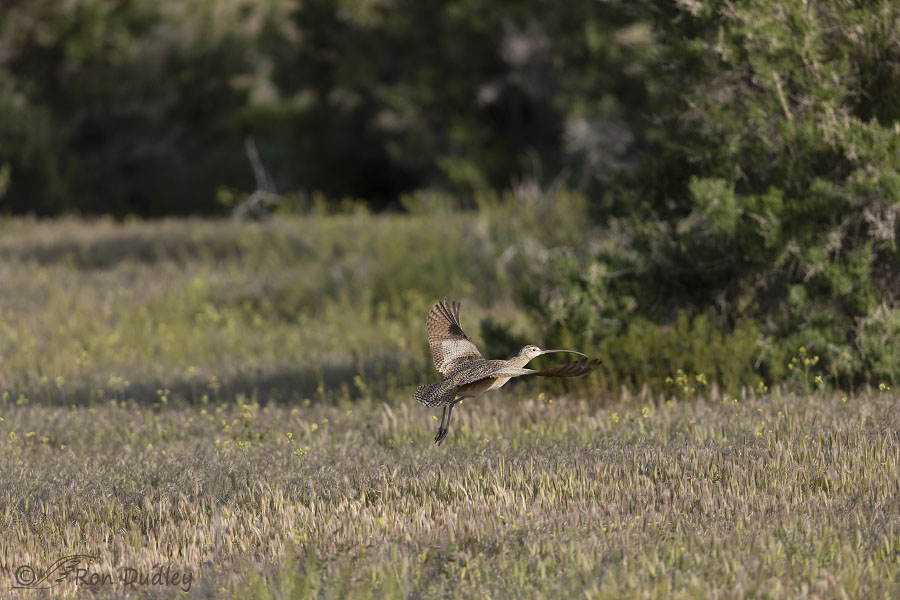
Before I present the rest of the series I think it will help my viewers to visualize how much I’ve cropped these images if I include this full frame (uncropped) version of the previous image. The curlew really was small in the frame. When he took off he flew slightly away from me so in the following images he becomes slowly but progressively even smaller in the original (uncropped) frames.
OK, let’s see the rest of the ‘evidence’. I won’t include narration because the images speak for themselves. At the end I’ll offer my personal conclusions, for what they’re worth.
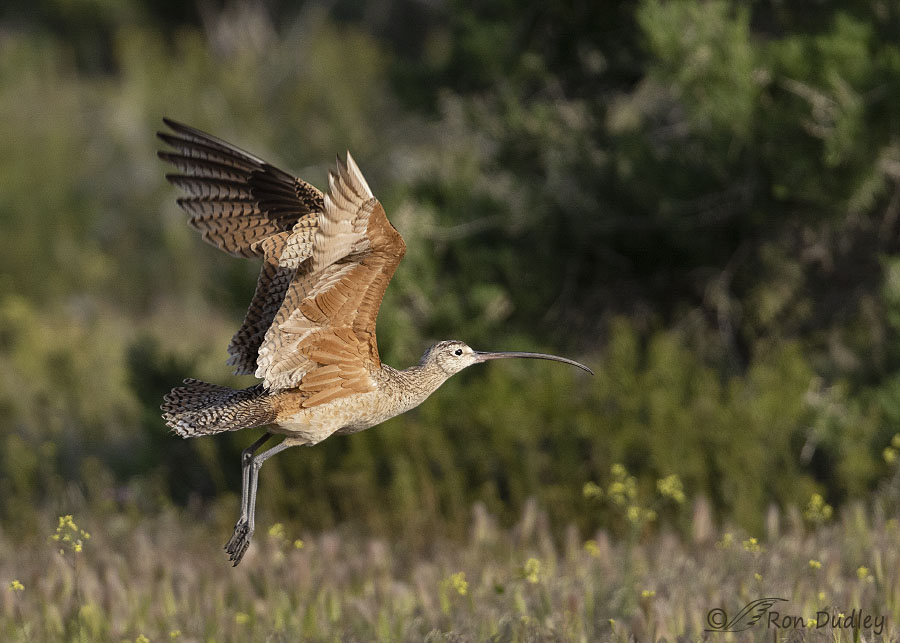
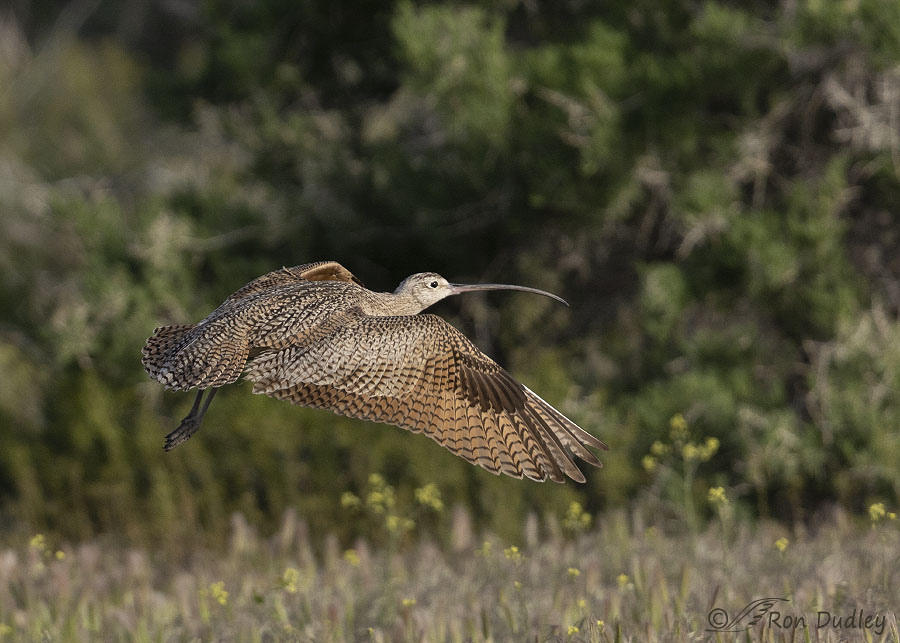
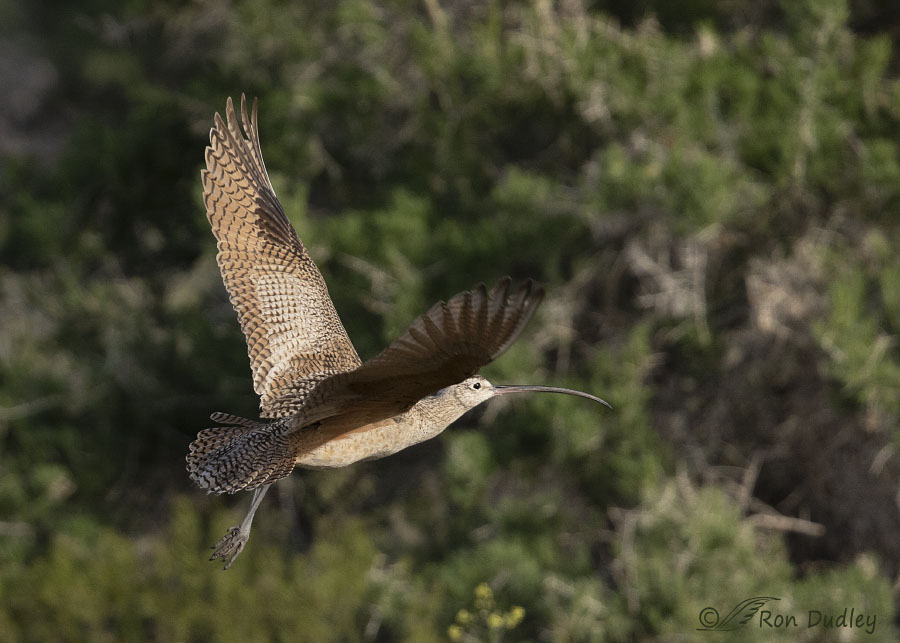
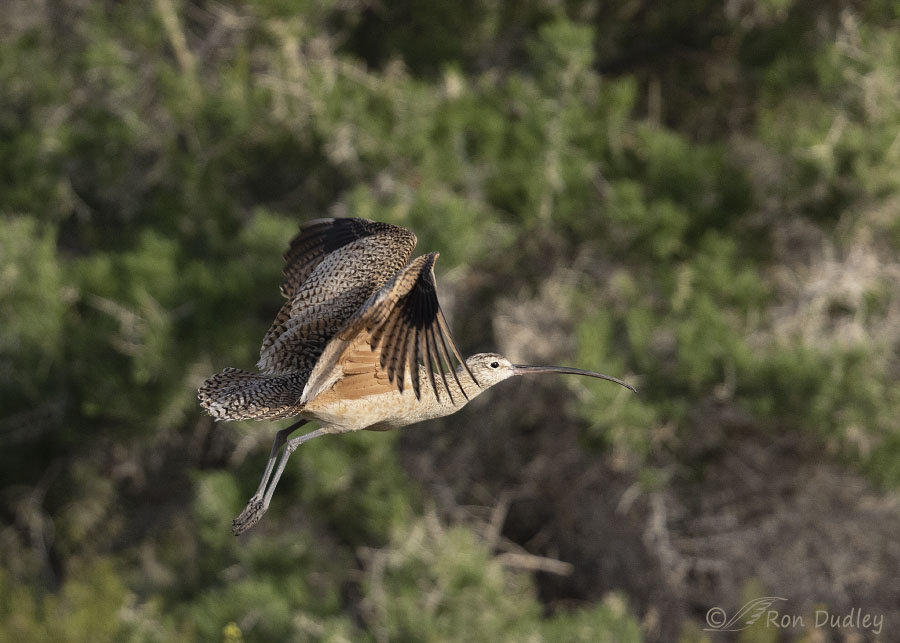
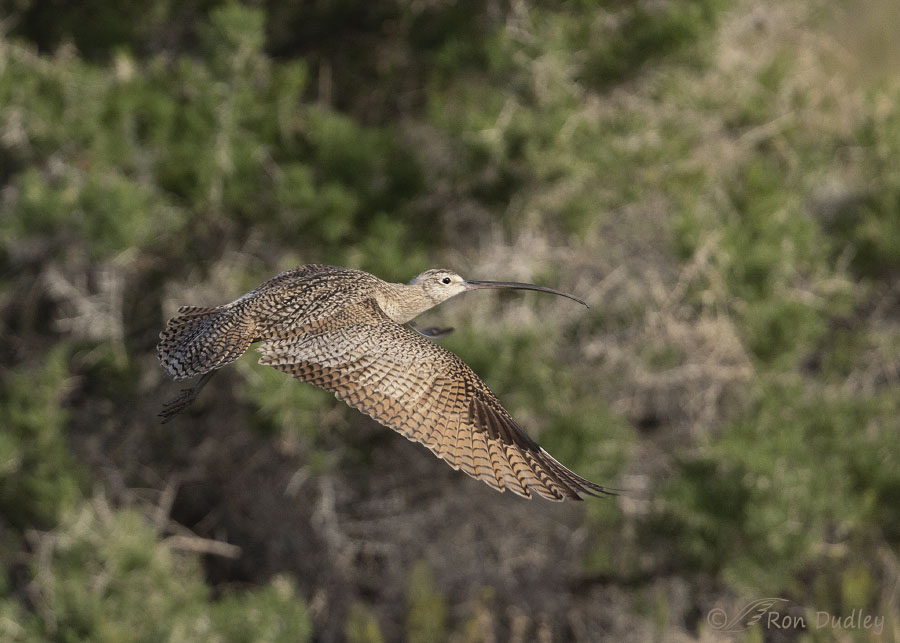
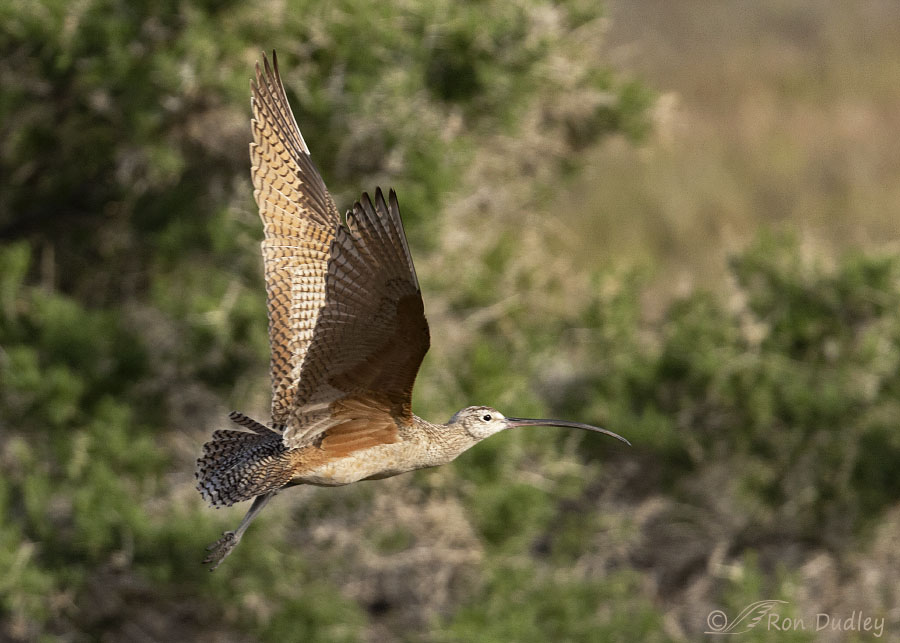
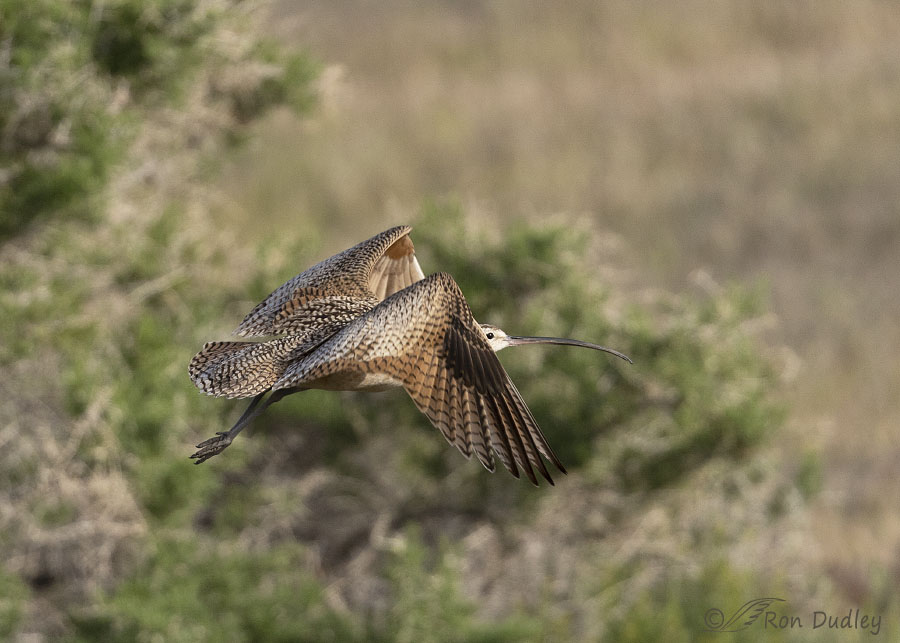
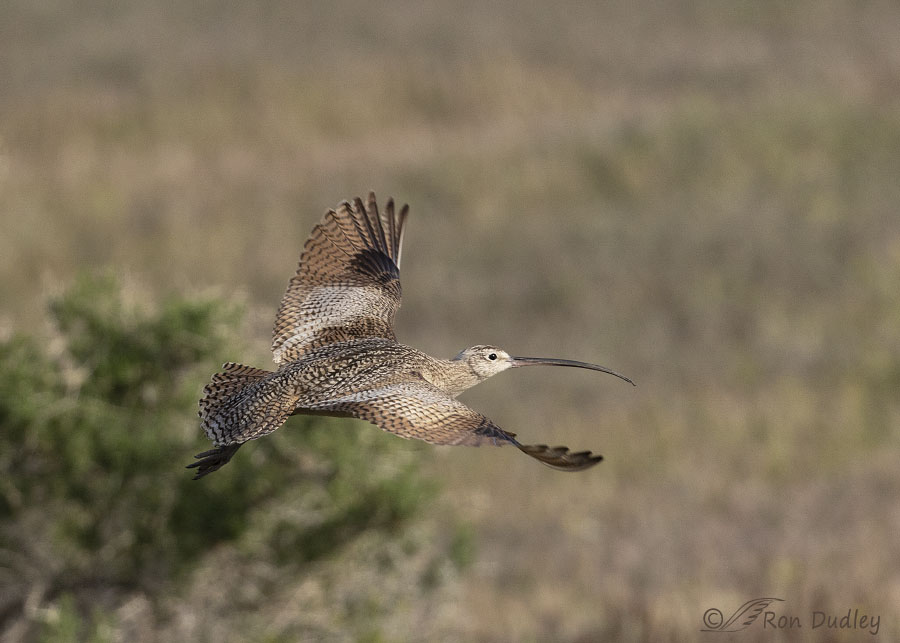
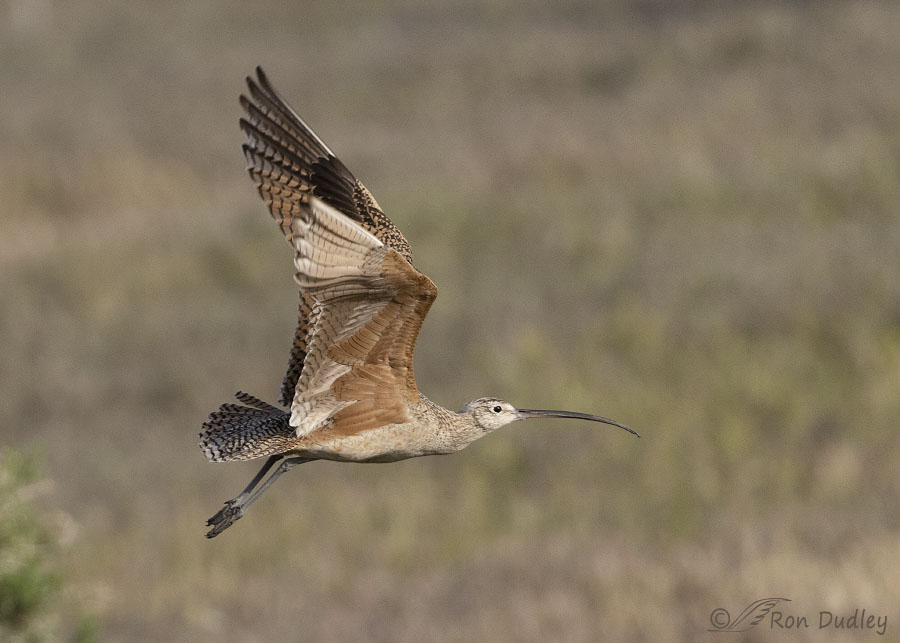
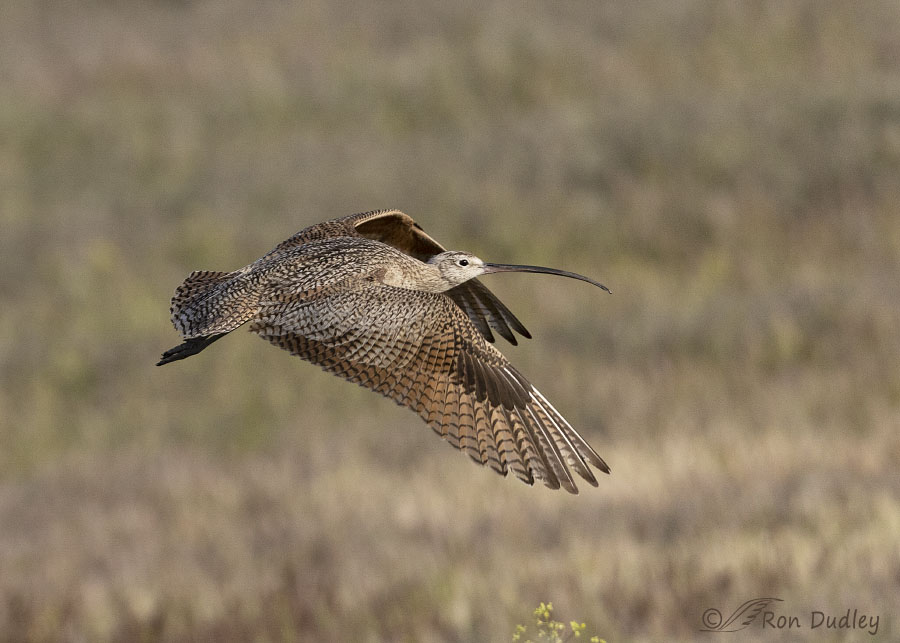
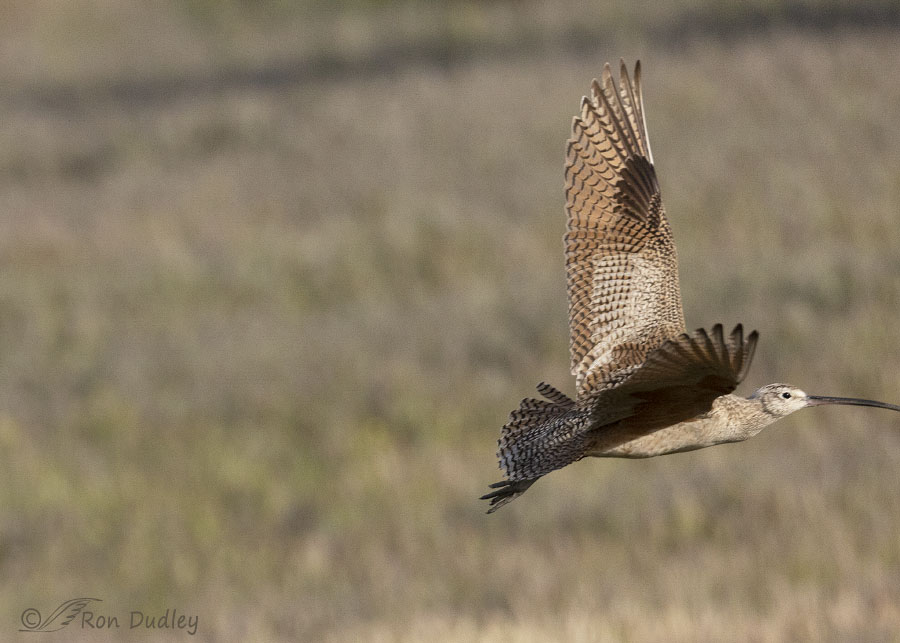
This is the last shot I got before the window opening of my pickup prevented me from swinging my lens any further to my right. If that hadn’t happened I’m confident that I would have many more sharp shots of the curlew. As it was, in this shot the bird had reached the right frame edge and I was beginning to lose sharp focus on him.
Conclusions:
- I’ve owned four different models of Canon cameras in the past and not one of them, in my hands at least, was capable of getting this many consecutive sharp shots of a bird in flight that was this far away, with the background this close to the bird and still have enough pixels to crop to get the bird this large in the frame and have acceptable image quality.
- Canon’s animal/eye detection is super-effective and when combined with the 46 MP file size of the R-5 it’s bird photographer’s dream.
- Would I have had better image quality and more detail if I’d been closer to the curlew? Of course. But these images, most of which would have been throwaways if I’d been using any of my previous cameras, are useable for many purposes – though not all (they’ve been cropped too much to print very large).
I realize that a single series of photos proves nothing. But for me this series is strong evidence of the pretty amazing capabilities of the R5 with birds in flight, especially when combined with other similar experiences I’ve had with my new camera.
If results like this continue I can easily put up with some of the aggravating quirks of the mirrorless Canon R5, even though at times they can be truly annoying.
Ron
PS – At some point I should probably cover some of the “annoying quirks” of the R5 in a blog post. I’ll try to do that sometime in the fairly near future.


I’m working my way back thru your posts from the past several days, so am very late to this party — and while all the photo-tech stuff is pretty much Greek/Geek to me, too, I enjoy reading your commentary and that of your readers. And so very glad you have no regrets about the purchase.
But that bird — oh my! Fantastic and fantastical! With that long bill, those long, beautiful wings and his long legs, I’m surprised he can get off the ground. I can almost “hear” the sound of it all as he rises and whooshes past in that close-cropped image. Just lovely.
Thank you for doing this review. I look forward to hearing about the quirks as I am trying to decide if this would be the right move for me.
Great Pics!
Thanks, Rene. I’ll try to get to the quirks fairly soon. I wish you luck with your decision – it’s a big one.
A little late for the party but I still want to thank you for this post.
It shows very well some of the capabilities of the Canon R5. Too bad it’s so expensive.
Thank you very much Ron.
“Too bad it’s so expensive”
Isn’t that the truth, Jorge. It took a chunk out of my savings, that’s for sure.
Well done – despite your initial reservations and those annoying quirks I think the proof is in the pudding – your recent results have been excellent.
As another mature-age adopter I find I now rarely reach fro my DSLR – the mirrorless just does a better job on 99% of images.
Keep up the good work.
Thanks, Gary. This morning I reached over and grabbed my DSLR for a few magpie shots but that was only because I was too close to the bird for the big lens I had on the R5 and I had a smaller lens on the 7DII.
Have you tried using the crop option on the camera and if so how does that compare to just cropping it in post processing?
Geoff, I started out using the crop option. But I prefer shooting full frame because it gives me more room in the frame for birds in flight and with the huge file size I can still crop down when I need to.
Nice series and good to know how you like it since I am probably going to buy the same camera. I am interested in the disadvantages and annoying quirks. You can pm me too if you like rather than a do a big blog report.
Thanks, April. You’re far from the only one interested in the R5’s quirks so I plan on doing a post about them.
I appreciate your occasional posts about tools, technology and methods that enhance the resulting efforts of the photographer’s eye. Your comments and the photo evidence clearly document the potential of the new camera. Oh, and Canon must be pleased…
Good to know, Susan. The operative word in your first sentence is probably “occasional”. I’ve got to be careful to not overdo the photo-geek stuff.
The proof is in the pudding. The R5, lens, and you were made for each other. I hope the Canon 7D Mark II is taking it well. I think you cheated a little bit by choosing such a beautiful subject.
Just wondering, were you using the eye detect feature for this series? More generally, are you using it as a default setting? Perhaps better answered in the (maybe) “annoying quirks” post.
Lyle, I always have animal eye detect set as default but I have 3 back buttons programmed for autofocus functions and two of them don’t use eye detection. But most of the time I’m using the back button that does use eye detection.
Ron,
Thanks, Ron. Let me know when your field test the Nikon mirrorless cameras! 😉
Stephen
Don’t hold your breath, Stephen. I haven’t owned a Nikon anything since my film days. Not that I have anything against Nikon, I don’t.
Marvelous series, Ron! Ooh and ahh! 🙂 Of course, it isn’t just the equipment — it’s the skill of the person using it!
Yes indeedy!
Thanks, Marty. I agree – you still have to have skill to take advantage of the R5’s features.
I could get lost in looking at all the browns and intricate patterns on the feathers. Thank you Ron!
You’re very welcome, Frances.
I’m not a photographer, so the tech stuff is Greek to me, but it is so interesting to see the uncropped image for reference of all the other shots. Thank you for including it, and for presenting all the images of this flight. It’s like we’re sitting next to you in your truck while this lesson unfolds, seeing what you are seeing in real time. Really neat!
I’m delighted to know that someone who isn’t a photographer would still find this post interesting. Thanks for letting me know, Carolyn.
My dad always said ‘use the right tool for the job.’ Sage advice! Bird Photography is your passion and good for you to keep improving your tools of the trade. These curlew shots do speak for themselves – Outstanding!
Thanks very much, Kathleen.
That R5 (and your use of it) is amazing. But $4K is a bit rich for me. I’ll stick with my 77D.
Believe me, Michael. It was a “bit rich” for me too.
Those shots are amazing. To me all your shots are amazing. Do you think the new shots are worth four thousand dollars more?
“Do you think the new shots are worth four thousand dollars more?”
So far at least I sure do, Ellen. But then bird photography, and doing it well, are an important part of my life. I’m sure many folks would have different priorities.
Hi Ron,
Thanks so much for sharing your thoughts on this as I really respect your opinion. With so many cameras on the market it can be overwhelming choosing one that caters towards wildlife photography. Great shots of a beautiful curlew.
Warm regards,
Tori
I appreciate your confidence in what I have to say, Tori. I hope it’s deserved.
These shots are amazing, Ron. I know you are pleased with these results proving that your investment in the R5 is a good one. Can’t wait for the Annoying Quirks Post!
I ran into one of those annoying quirks this morning, Melanie. Did some cussing as a result.
Wow Ron – remarkable images for shots taken so far away. If I was much younger you would be driving me out there to buy one. Birds in flight is my weakness. Thanks for posting.
“If I was much younger…”
Look at it this way, Everett. There’s at least one advantage to being older – in this situation it’s saving you a fist-full of money!
Oh my! What a stunning series of such a striking bird! Thanks for sharing, Ron.
Thank you, Diane.
Hi Ron. I got my R5 a couple of weeks after you got yours, upgrading from a 7DmkII as well. I never thought I’d be such a Huge Fan of the R5, having been very (very) satisfied with my 7DmkII.
But, I find that I too am getting way more pics in focus with the R5. I do shoot with the electronic shutter and find that I like it a lot. No more noise to scare the birdies when I’m shooting. The 20 frames per second of H+ mode do indeed drop a lot of duplicate frames in your lap, and I’m spending a whole lot more time culling pics. But…the R5 is amazing IMHO.
Very nice write-up today! I enjoy your daily blog Very Much!
Thanks Ron!
Rick, 20 frames/sec is way more than I usually need and I hate getting all those duplicate images and having to spend so much time culling. On the other hand, I do miss an occasional great shot at “only” 12 frames/sec.
Tradeoffs. Why does there have to be so many tradeoffs in bird photography…
Wow. Wow and wow again.
Thank you and your new camera so much for giving me these detailed looks at the beauty of the ‘improbable bird’.
Thanks, EC.
Nice review, Ron. I look forward to the “quirky” evaluation!
Thanks, Brett. I hope to do it before too long.
Oh Oh, you are making me contemplate a new camera! These are beautiful images, and the fact you were able to capture as many sharp images from such a distance makes a huge difference to me.
We don’t have the space you have out West and therefore our distance to subject, although can be close at times, is usually quite a distance. I am impressed and waiting for more information before I spend that kind of money. Love your shots!!
I know, Dick – it’s a big decision. At this point at least I’m glad I made the switch.
I’m impressed! Wonderful, sharp series of the Curlew! 🙂 Always “trade-offs” with these things – battery life can be a real PITA.
Using the electronic shutter or not is WAY beyond me – didn’t know it was an “option”. 😉
Judy, you have the choice to use the electronic shutter or not. For my style of shooting the ES too fast when shooting bursts – too many duplicate images and too many images to cull.
Are you using the electronic shutter at 20 frames per second? What do you think of the battery life? I am formatting my cards and recharging my batteries often…more often than I did with my other cameras. I guess that is because I am taking many more images with the electronic shutter, I am getting many images (at least 6) for a single press for a perched bird as opposed to the 1 or 2 that I go with my 80D.
No, I’m not using the electronic shutter. In most situations I think the disadvantages of using it outweigh the advantages.
If the R5 has an Achilles heel it’s battery life.